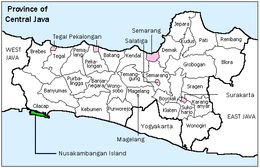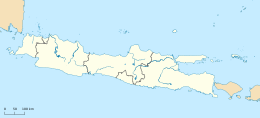
Back نوسا كامبانجان Arabic نوسا كامبانجان ARZ নুসা কামবাঙ্গান Bengali/Bangla Pulau Nusakambangan CEB Nusa Kambangan German Nusa Kambangan French Nusakambangan ID Nusa Kambangan JV Pulo Nusakambangan MAP-BMS Nusa Kambangan MIN
 Location of Nusa Kambangan (green) in Central Java | |
| Geography | |
|---|---|
| Location | Southeast Asia |
| Coordinates | 7°45′S 108°55′E / 7.750°S 108.917°E |
| Area | 121 km2 (47 sq mi) |
| Administration | |
Indonesia | |
| Province | Central Java |
| Regency | Cilacap |
| Demographics | |
| Population | Around 3000 natives, and several hundred inmates |
| Pop. density | 24/km2 (62/sq mi) |
| Ethnic groups | Banyumasan people |
| Additional information | |
| Time zone | |
Nusa Kambangan[a] is an island located in Indonesia, separated by a narrow strait from the south coast of Java. The closest port is Cilacap in Central Java province. It is known as the place where the fabled wijayakusuma, which translates as the 'flower of victory' in the highest literary register of the Javanese language, grows. The wijayakusuma can be used to bring a person back from the dead, and the princes of the Sultanate of Mataram and later the Surakarta Sunanate sent to the island for the blooms in order to become kings.[1][2][3] Thus the island is also known as pulau bunga-bungaan, the 'island of many flowers'. There is a forest reserve on the island. One of the main cultural events is Sedekah Laut (sea sacrifice), which is held by the Surakarta Sunanate every Satu Suro (new year) in the Javanese calendar. Since the Dutch colonial period, there have been a number of supermax prisons on the island, some of which are still operational and run by the Ministry of Law and Human Rights.
Cite error: There are <ref group=lower-alpha> tags or {{efn}} templates on this page, but the references will not show without a {{reflist|group=lower-alpha}} template or {{notelist}} template (see the help page).
- ^ Mohammad, Ghamal Satya (1 January 2014). "Widjojo Koesoemo (Wijaya Kusuma) Between Tradition and Science, 1830 - 1939". BA Thesis, Leiden University, The Netherlands.
- ^ Brakel, Clara (1997). ""Sandhang-pangan" for the Goddess: Offerings to Sang Hyang Bathari Durga and Nyai Lara Kidul". Asian Folklore Studies. 56 (2): 253–283. doi:10.2307/1178727. ISSN 0385-2342.
- ^ "111. HASIL DAN PEMBAHASAN - PDF Free Download". adoc.pub. Retrieved 6 December 2024.

